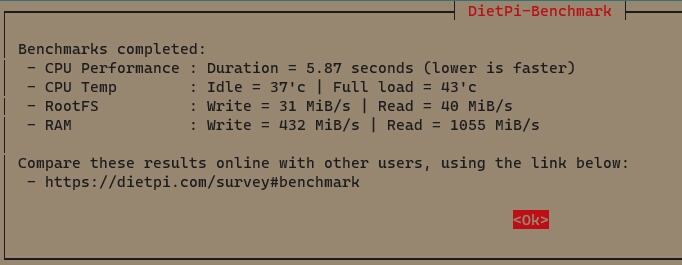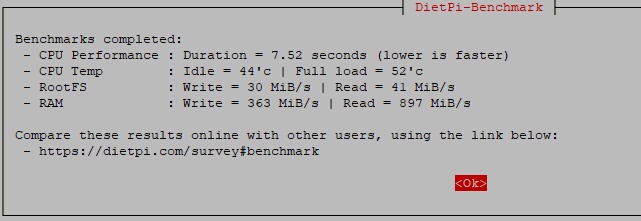Hello community, just noticed PI as now released Bullseye OS.
Currently I’m on Buster - v 7.7.3 of DietPi
Is there a planned upgrade or new version based on Bullseye forthcoming?
Hello community, just noticed PI as now released Bullseye OS.
Currently I’m on Buster - v 7.7.3 of DietPi
Is there a planned upgrade or new version based on Bullseye forthcoming?
DietPi is already on Bullseye, but if you’re expecting that free 300Mhz boost for the recently new c0 stepping of the Raspberry Pi 4B then I think it will need to be added in by DietPi devs with a small patch, or next update.
I’ve not been brave enough to manually change my arm_freq= to 1800 in config.txt though. Plus I’m not sure if it will work, I’ve seen others use “arm_boost=1” instead. Has anyone else successfully done it?
How to find out if you have new c0 stepping without taking off your heatsink (doesn’t require sudo):
od -An -tx1 /proc/device-tree/emmc2bus/dma-ranges
If the second line begins with 40, you have the older B0 CPU. If it begins with fc, you have the newer C0 CPU (source:
https://github.com/raspberrypi/linux/issues/3210#issuecomment-680035201)
That is what I was hoping for. But seems I have an older model, even though it is one with 8GB
I did manage to get the system upgraded tough for anyone else looking for the information on how to upgrade: https://dietpi.com/blog/?p=811
DietPi v7.8 will update the Raspberry Pi 4 and 400 overclocking profiles: https://github.com/MichaIng/DietPi/blob/3a79357/dietpi/dietpi-config#L3595-L3639
I also recognised the arm_boost=1 from the new Raspberry Pi OS Bullseye image, being present by default for RPi 4 models. Not sure which frequencies it applies. Should be safe to apply (commenting all other “_freq” settings) and check the result via cpu.
I decided to wait until the update was released, so I upgraded to 7.8 today and rebooted, but did not see the new 1800 MHz default profile for my RPi 4B (dietpi-config still shows 1500 MHz for default). I uncommented the arm_freq line and added arm_boost=1 and rebooted again, cpu command now shows a max frequency of 1800 MHz
If it matters, I also had a reboot pending for applying the safe profile a couple days ago, but instead of rebooting I went ahead with dietpi-update to 7.8 instead. Could that have messed with the pending config.txt changes?
On RPi 4, 1500 MHz is the correct default. Only on RPi 400 the default is 1800 MHz. This seems to be stable on RPi 4 as well, though, and it is hence among others an overclocking profile that can be found in dietpi-config > Performance Options > Overckocking.
What does vcgencmd measure_volts show in your case?
If arm_boost=1 enables the 1800 Mhz only, the I prefer use the generic RPi overclocking method to set CPU, GPU and RAM frequencies + voltage individually to a stable and reasonable combination.
it shows volt=0.8600V
Is there a way to view the current gpu and ram frequencies?
vcgencmd measure_clock core
for the GPU core, for SDRAM frequencies there is sadly no command I’m aware of.
for the gpu core: frequency(1)=374269056
I found a benchmark ss I took when I bought the pi last month, it does seem to have had improvements to memory frequencies too (edit: 2nd screenshot is with arm_boost):


For the GPU core clock, could you run this command again after a stress test on another SSH screen? All frequencies are scaled together with the CPU, hence the frequency you saw was likely in a near idle mode.
Probably all maximum frequencies can also be seen via:
vcgencmd get_config int
Ah, about the RAM frequency: I totally forgot that it is hardcoded on RPi 4 to 3200 MHz, so the changed RAM I/O is then a result of increased CPU and GPU speed. GPU core has also a minor impact on RAM speed as it drives the memory bus, AFAIK.
Sure, here’s the output while stress test (cpu & ram) was running in another screen:
aaron@DietPi:~$ sudo vcgencmd measure_clock core
frequency(1)=500000992
aaron@DietPi:~$ sudo vcgencmd get_config int
arm_64bit=1
arm_boost=1
arm_freq=1800
audio_pwm_mode=514
config_hdmi_boost=5
core_freq=500
core_freq_min=200
disable_commandline_tags=2
disable_l2cache=1
disable_overscan=1
disable_splash=1
display_hdmi_rotate=-1
display_lcd_rotate=-1
dvfs=3
enable_gic=1
force_eeprom_read=1
force_pwm_open=1
framebuffer_depth=16
framebuffer_ignore_alpha=1
framebuffer_swap=1
gpu_freq=500
gpu_freq_min=250
init_uart_clock=0x2dc6c00
initial_turbo=20
lcd_framerate=60
max_framebuffers=-1
over_voltage_avs=-20000
pause_burst_frames=1
program_serial_random=1
temp_limit=75
total_mem=4096
hdmi_force_cec_address:0=65535
hdmi_force_cec_address:1=65535
hdmi_pixel_freq_limit:0=0x11e1a300
hdmi_pixel_freq_limit:1=0x11e1a300
Okay, so it is only the CPU frequency which was raised. GPU runs at default frequency: https://www.raspberrypi.com/documentation/computers/config_txt.html#overclocking
Good to know that this seems to run stable now without overvoltage. Our profile which matches these frequencies still applies +2 overvoltage. Looks like this can be enhanced a little to reduce power consumption = head dissipation ![]() .
.